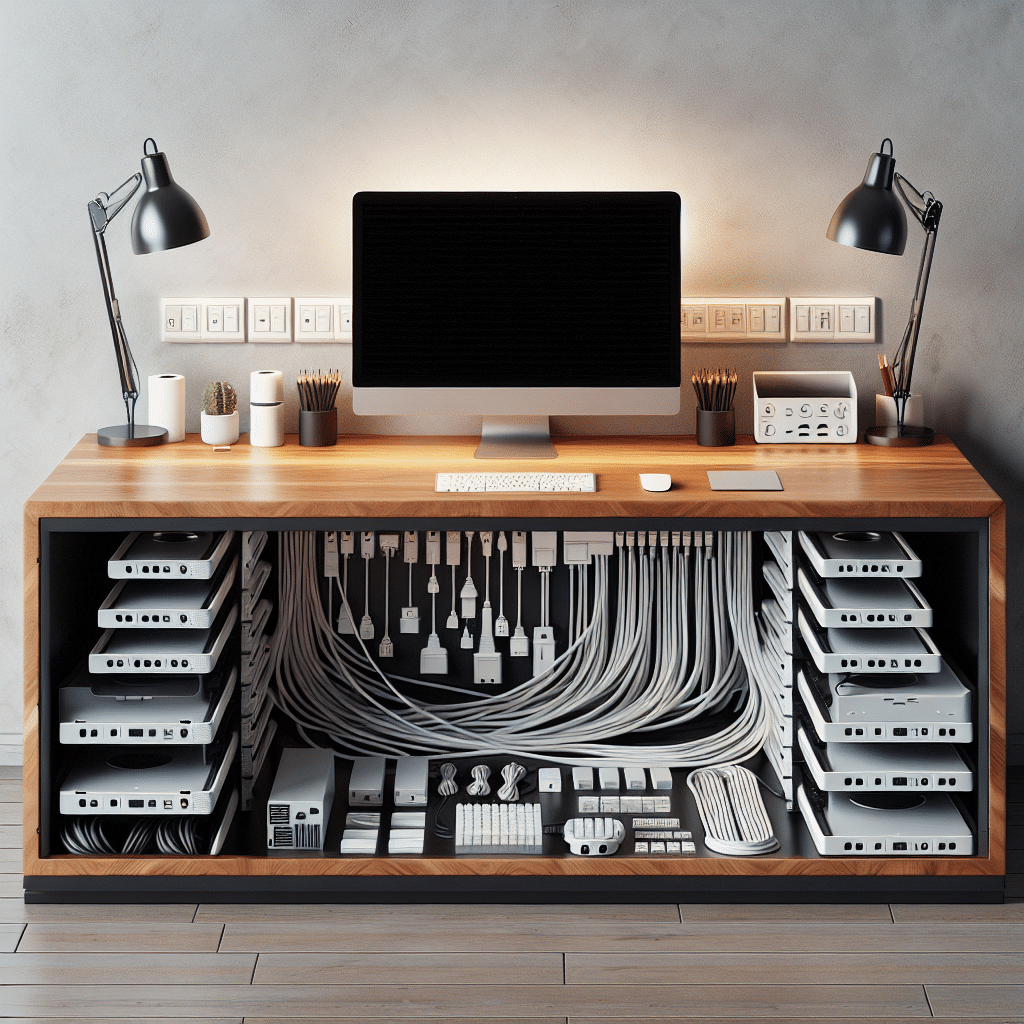Understanding Cable Management
Cable management is critical in maintaining a tidy workspace, especially with the increasing number of devices in modern offices and home setups. Proper cable management not only improves aesthetics but also enhances safety by reducing tripping hazards and prolonging the lifespan of cables.
Why Cable Management Matters
- Safety: Cluttered cables can become tripping hazards. Keeping cables organized minimizes the risk of accidents.
- Productivity: A clean desk helps reduce distractions, allowing for a more focused and productive work environment.
- Device Longevity: Over time, tangles and stress on cables can lead to wear and tear, ultimately damaging devices. Proper management ensures cables remain intact.
- Aesthetics: A neatly managed cable system enhances the overall appearance of your desk, contributing to a more professional look.
Best Practices for Cable Management
-
Plan Your Layout:
- Before setting up your workspace, envision the layout. Identify power sources, device locations, and potential cable pathways to minimize visible clutter.
-
Group Devices:
- All devices that will be used together should be positioned close to each other. Group your computer, monitor, printer, and any other peripherals for seamless connectivity.
-
Use Cable Sleeves:
- Cable sleeves are fabric or plastic tubes that bundle multiple cables together. They not only keep the cables organized but also provide a professional look.
- Sleeves can be cut to length, allowing customization based on your needs.
-
Cable Clips and Holders:
- Use adhesive cable clips or holders. These can be attached to the underside of your desk to guide cables out of sight.
- Clips are perfect for keeping cords from hanging down or tangling with one another.
-
Cable Management Boxes:
- For larger cables and power strips, consider using cable management boxes. These boxes conceal clutter while allowing easy access to power outlets.
- Look for boxes that provide ventilation to prevent overheating.
-
Velcro Ties and Zip Ties:
- Use Velcro ties for flexibility; they can be adjusted easily as you add or remove cords.
- Zip ties offer a more permanent solution but lack the adjustability of Velcro.
-
Under-Desk Cable Trays:
- Install cable trays beneath the desk. They provide a spacious area to organize power strips and excess cord lengths.
- Ensure trays have a design that allows airflow, preventing overheating of devices.
-
Cable Management Kits:
- Consider pre-packaged cable management kits that include sleeves, clips, ties, and trays. These kits often feature a variety of tools customized to fit different needs.
Specialized Cable Management Solutions
-
Desk Grommets:
- Desk grommets are inserts that provide a neat passage through the desk’s surface for cables. They keep connections accessible while maintaining a clean look.
- Available in various sizes and styles, choose a grommet that fits your desk design.
-
Cable Raceway:
- Raceways are channels that protect and hide cables along walls or from the floor. These can be painted to match your decor and provide a seamless appearance.
- Ideal for offices with multiple desks, they solve the issue of floor clutter effectively.
-
Adjustable Cable Management Arms:
- For adjustable sit-stand desks, use attachable cable management arms. These arms can move with the desk, maintaining organization regardless of height adjustment.
- They prevent tension on the cables during transitions.
-
Magnetic Cable Organizers:
- Magnetic clips can hold cables securely in place for easy access. They are useful for desks where cables frequently need to be disconnected and reconnected.
- This solution offers flexibility without permanent installation.
Tips for Specific Devices
-
Laptop Setups:
- Use a docking station to reduce cable clutter. Docking stations centralize power and connectivity, reducing the number of visible cables.
- Utilize vertical laptop stands to free up desk space and hide charging cables behind the devices.
-
Gaming Setups:
- Use a dedicated cable management box to hide all gaming console cables. Place the consoles on a shelf or hidden area to minimize visible clutter.
- Consider LED strips that direct power and minimize congestion by attaching cords upward and out of sight.
-
Home Office Solutions:
- For multiple monitors, install a monitor arm that includes integrated cable management capabilities.
- Utilize wall-mounted shelves for printers and other peripherals, reducing desktop cable presence.
Maintenance and Regular Checks
Regularly checking and maintaining your cable management system is essential. Here are some practices to keep in mind:
- Check for Wear and Tear: Periodically inspect cables for damage such as fraying or burns, which may be signs of potential issues.
- Reorganize as Needed: With new devices regularly being added to your setup, take the time every few months to reassess your cable management to accommodate new equipment.
- Dust Regularly: Dust can accumulate in cable management boxes and around cables. Regular cleaning maintains aesthetics and prevents overheating.
Conclusion
Incorporating effective cable management solutions into your desk setup promotes a safer, more efficient, and aesthetically pleasing workspace. By strategically planning your layout and employing tools like sleeves, clips, and trays, you can ensure that your cables are organized and your workspace remains clutter-free.
